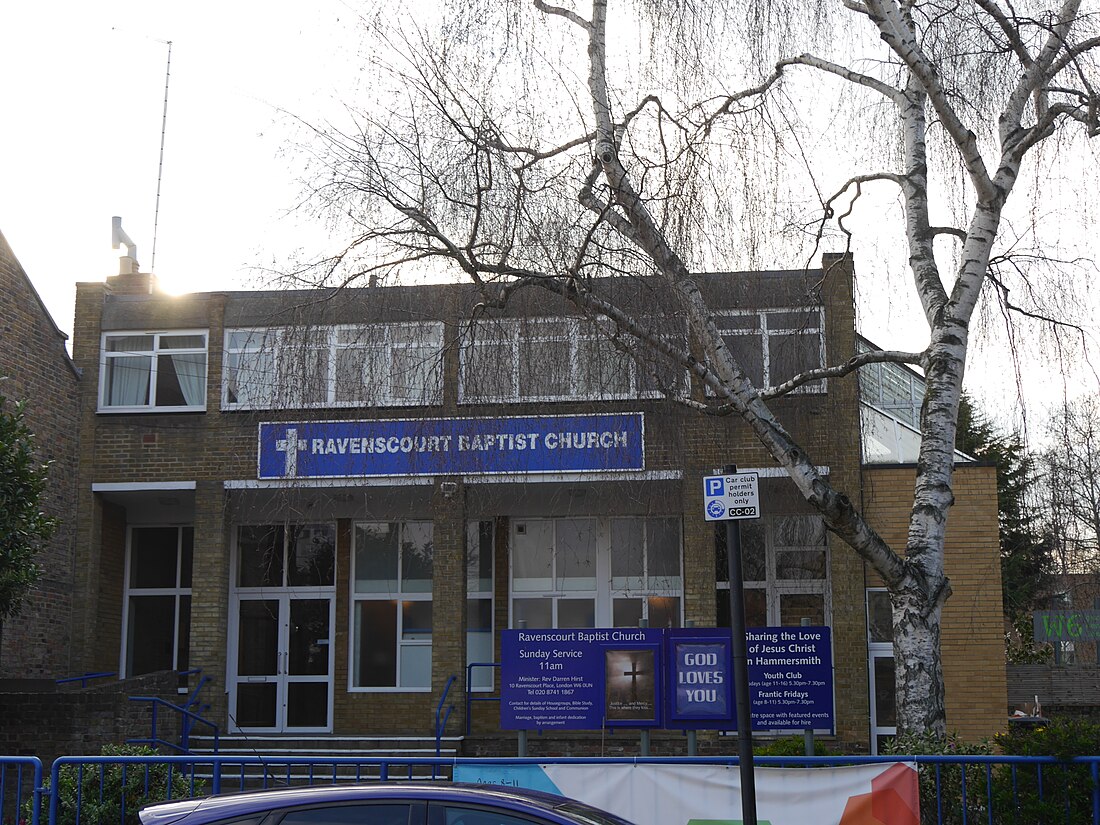Top Qs
Timeline
Chat
Perspective
Ravenscourt Baptist Church
Church in Hammersmith, London From Wikipedia, the free encyclopedia
Remove ads
Ravenscourt Baptist Church is a church in Ravenscourt Road, Hammersmith, London. It was established in 1793 as the West End Baptist Church.[1] The current building opposite the Ravenscourt Park tube station opened in 1971.[2][3]
Remove ads
History
Summarize
Perspective
A society of Baptists first started meeting on Hampshire Hog Lane in Hammersmith as early as 1768.[1][4] The exact location of the meeting house is unknown.[4] In 1788, a new meeting house built by Samuel Naylor was opened on King Street.[4] For two years, it was occupied by Baptists, after which it was let to another religious society, possibly Methodists, who called the building Trinity Chapel.[4]
By November 1793, the building was again taken over by Baptists, forming what became known for over 200 years as the West End Baptist Church.[4] In 1808, the church started a Sunday school for boys, which was opened to girls in 1839.[1]
A larger church building was built in 1851.[1] The West End Baptist Church on King Street was famously depicted in a painting by A. J. Messenger at the Royal Academy of Arts, described as "indicative of the heaviness of the Victorian style of buildings".[2]
Further modifications were made to the building in 1902.[1] By 1909, it had 630 members.[1]
By the 1960s, the church found it difficult to maintain the premises.[1] On 12 June 1971, four foundation stones, including three taken from the old premises, were laid for a new church building on Ravenscourt Road.[5] Church documents dating back to the 19th century, sealed in glass jars, became part of the new structure.[5] The minister at the time was the Reverend Frederick Hemmens.[6][5]
Later that year, excavators were tasked with digging up graves dating back to 1793 in the old church cemetery, after a special bill was passed in Parliament authorising development of the land, and Royal assent was granted in December 1970.[7][2] The cemetery had been used to bury dissenters who were not allowed to be buried on the "consecrated ground" of the Anglican Church.[7] As of 18 November 1971, eight skeletons had been unearthed; they were thought to be approximately 150 years old.[7]
The current church and hall block opened in 1972, with a new entrance on Ravenscourt Road.[1] The new church, which cost £78,000 to build, had a chapel seating 240 people, a large hall, two small halls, and a caretaker's two-bedroomed flat.[2][6] The front hall block on King Street became part of the Polish Social and Cultural Centre.[1]
In subsequent decades, church membership declined.[1] By 1993, it had only 40 members.[1]
Remove ads
References
External links
Wikiwand - on
Seamless Wikipedia browsing. On steroids.
Remove ads


